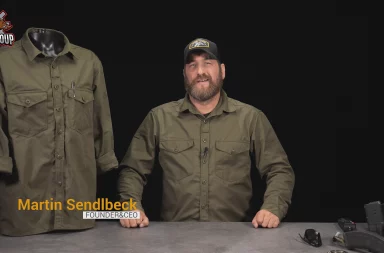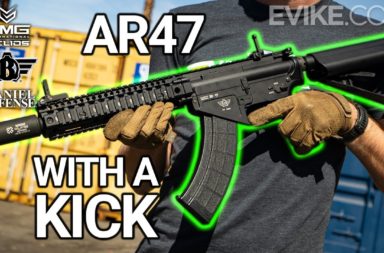Nurpol Delta Spec Ops: It’s still a Honey Badger!
In this review, we’ll be taking a closer look at Nuprol’s Delta Spec Ops AEG. Nuprol is relatively new to the Airsoft gun market and already has a decent line-up of rebranded guns. It’s no secret that the “Delta Spec Ops” is a rebrand of Ares’ Amoeba AM-14, also known as the “Honey Badger PDW”, but with slight differences. The thing I like about Nuprol is, that they don’t make it a secret at all. They clearly show the Ares/Amoeba logo on the box and on various parts on the gun and say, that it’s made by Ares. With Nurpol being an European company, you’ll get all the Ares goodness combined with European service and warranty without having to deal with companies overseas directly.
The Spec Ops/Honey Badger is a pretty well known AEG within the Airsoft community and doesn’t need an introduction. Let’s get down to the facts.
The Box
The Delta Spec Ops comes in a decent cardboard box with various warnings in different languages printed onto it. The AEG is wrapped in a plastic bag and the high-cap mag sits in a dedicated slot inside the cardboard insert. You also get a manual … but who reads the manual anyways, right?
The Delta Spec Ops features:Feature Overview
- Polymer body
- A compact retractable stock
- Aluminum Mock-up suppressor (inner barrel extends all the way trough the suppressor)
- CNC 6063 aluminum free-float handguard with 2 RIS rails
- Polycarbonate flip-up sights
- Enlarged magazine release button
- Aluminum 6.03mm inner barrel
- EFCS gear box
- Quick Spring Change system
- Available in Black and Tan
The main difference between the Ares and Nuprol version:
- Missing Amoeba Logo on the lower receiver / Nuprol markings / different fire selector markings
- Classic AR lower receiver style
- Classic AR-style mag instead of Amoeba mag
- Different trigger guard
- Different pistol grip
- Missing lower RIS rail on the handguard (at least on my review sample)
Externals: Stock
The stock houses the 7.4V PEQ-style LiPo battery and there’s little to no room for battery upgrades. You might find a way of putting 3 3.3V LiFe batteries in there or a 3S LiPo that has the right size. But other than that, you’re pretty much set on the PEQ-style battery.
The stock has 3 positions and can be removed without any hassle – just push the buttons and pull it out. I find it quite hard to adjust the stock with just my left hand while holding the gun with the other as you have to push both of the buttons at the same time and pull or push the stock.
The stock has some slight amount of wobble but it’s not really noticeable while playing.
Externals: Pistol Grip
The pistol grip is quite comfortable in terms of ergonomics. It features two anti-slip textures on the front and rear. The grip feels pretty slim for an AR grip, not as slim as a Systema but way slimmer than your average Airsoft AR grip. The finish of the anti-slip inserts is good although there’s some sort of debris left from the casting.
The motor plate features a skeleton design for better airflow and cooling of the motor.
Externals: Receiver
The receiver seems to be similar to the other AR receivers Ares is using on their Amoeba models. It’s made out polycarbonate and is not only very sturdy but also very well made. Ares is making some of the best “plastic” receivers I’ve ever seen. I’m actually a fan of plastic receivers.
The lower receiver features an extended magwell for faster reloads and modernly shaped trigger guard, the rest of the lower receiver is pretty much identical to a classic AR receiver in terms of looks.
A very convenient feature is the extended mag release button, which is totally easy to push thanks to its size and texture.
Externals: Frontend
The rail is made out of 6063 aluminum and features various mounting holes for rails and accessories. You can take the top rail off and mount it on the bottom or on any other place you desire. I’m not sure if the final retail model will include more rails than my review sample does.
The rail itself is mounted pretty tightly to the receiver. No wobbles, nothing.
The suppressor has no sound dampening features as the inner barrel extends all the way trough the suppressor. It’s pretty much just for the looks. But hey, you’ll get a longer inner barrel instead.
Externals: Sights
The sights are pretty much basic polycarbonate flip-up sights which can be adjusted. You can easily flip them up and down without having to push any buttons at all. You’ll put an optic on top of that rail anyways, won’t you?
Internals: Hop-Up / Inner Barrel
The hop-up used in the Delta Spec Ops is basically a standard V2 hop-up unit that uses a big rotating dial instead of multiple gears. This kind of hop-up is becoming the standard for V2 hop-ups more and more. It’s air-tight, well built and uses a standard-type bucking.
The inner barrel is a 6.03mm aluminum tight-bore barrel.
Internals: Motor
The motor is described as a “high torque” one but the magnets are quite weak for a “high torque” type. It has no markings on it and no decals.
Internals: EFCS & Gearbox
Ok, now it’s time to take a look at the most important feature of the gun: the Ares EFCS (Electronic Firing Control System) and, of course, the gearbox and its internal parts.
The EFCS is quite a one-of-a-kind system and is very similar to the one Systema is using in their PTWs. The EFCS features an active breaking mosfet and a two magnetic sensors that control the piston cycle (cycle completion) and the firing mode. The EFCS unit is also programmable with an external unit. You can program various shooting modes and the battery voltage / LiPo cells.
We’ll get into all the details step-by-step.
The first thing you’ll notice is the small sensor that is placed in an 90° angle to the circuit board. This is a magnetic sensor. The sector gear features a small magnet that rotates past the magnetic sensor and so the circuit board knows where the sector gear is positioned. The EFCS features cycle completion, which means that every time you pull the trigger, the sector gear, thanks to the active-breaking mosfet, stops at the very same position, in semi as well as full-auto mode. So basically that’s what the magnetic sensor is there for.
Due to the small magnet inside the sector gear, it’s quite hard to replace the gear set with an aftermarket one. You’d need to insert the magnet into the new gear set, which is quite a pain as there is no standard for the size of the holes. I saw one video on Youtube where a guy used a G&P sector gear that he was able to insert the magnet into.
A better solution would be to insert the magnet into the delayer clip as you could use the delayer clip on other sector gears too. Just for the sake of upgrades.
The firing mode is also controlled via a sensor. This means that there’s no need for a cut-off lever.
The cycle completion and the magnetic selector plate aren’t the only features of the EFCS system. The circuit board can also be programmed with an external programmer unit (available separately) for various shooting modes:
- Safe – Semi – Auto
- Safe – Semi – 3rds Burst
- Safe – 3rds Burst – Auto
- Safe – Semi – Semi
Another feature of the EFCS is the auto power-off feature in case any internal parts break / fail.
As you’ve already guessed, the gearbox shell is proprietary and can’t be replaced with an aftermarket one and you also can’t place the EFCS circuit board into any other V2 shells. At least not without heavily modifying the shell. However, the EFCS gearbox is fully compatible with any AR-style guns that use a standard V2 shell and a standard AR receiver.
The gearbox also features a simple quick spring change system. The spring guide can be removed by using a hex key.
Internals: Parts
Now that we’ve taken a closer look at the EFCS system it’s time to check out the internal parts of the gearbox.
One thing you don’t see that often in a V2 gearbox is a motor mounting plate. This feature probably adds some stability and is a nice feature nevertheless.
I can’t say much about the gear set as it looks rather standard. Ares advertises the gear set as a “high strength” one.
The spring guide is made out of steel and doesn’t feature any bearings. The spring is quite powerful and the chrono readings were between 350 and 355 feet per second straight out of the box. Thanks to the quick spring change system, changing the spring takes only a couple of minutes.
The cylinder set is well made and the tolerances are very low. the compression is good.
The polymer nozzle features an o-ring.
The polycarbonate piston has the penultimate tooth being shaved off to ensure that the sector gear doesn’t interfere in case the AOE is off.
Conclusion
The Spec Ops is a great addition to Nurpol’s line-up. The gun is very well built and quite solid. The internal parts are very well made, the cylinder kit has almost no tolerances and FPS fluctuation is quite low. I was able to hit targets at a distance of 75m (which is the longest distance I can test at the moment). The hop-up works great and I only had to turn it up a little bit to achieve my desired trajectory.
The EFCS system is working very, very well and I really love the cycle completion and the electronic trigger. Again, the only little downer here is the incompatibility with third-party gear sets. Yes, Ares also offers different gear sets for the EFCS gearbox but each player has his own preference when it comes to gear ratios and brands.
Available for a retail price of around 300€, the Nuprol Delta: Spec Ops is actually a bang for the buck.
 Our friends from Gunfire just got the Nurpol Delta Spec Ops in stock! Be sure to head over to their website and check out all the other Nurpol products they are offering.
Our friends from Gunfire just got the Nurpol Delta Spec Ops in stock! Be sure to head over to their website and check out all the other Nurpol products they are offering.































